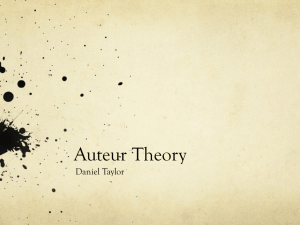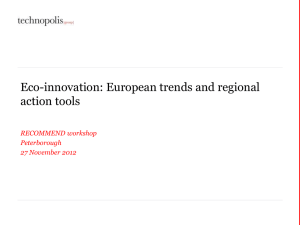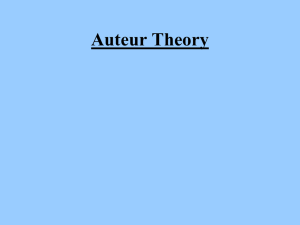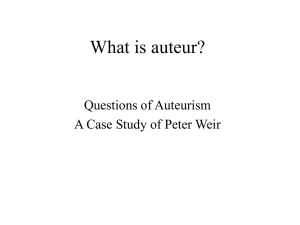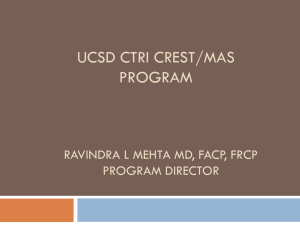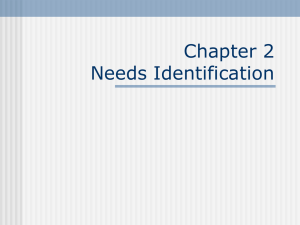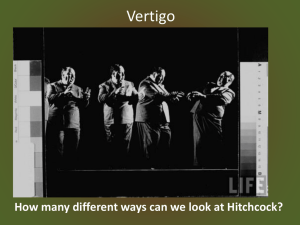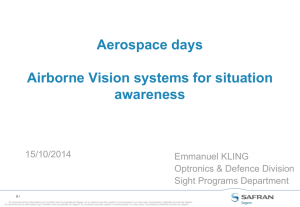ANR-ERANET-WORKSHIP - Hal-SHS
advertisement
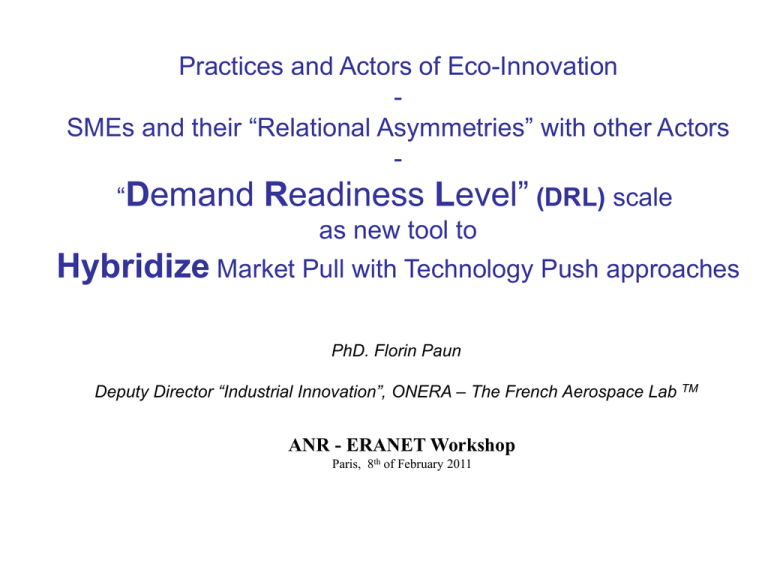
Practices and Actors of Eco-Innovation SMEs and their “Relational Asymmetries” with other Actors “Demand Readiness Level” (DRL) scale as new tool to Hybridize Market Pull with Technology Push approaches PhD. Florin Paun Deputy Director “Industrial Innovation”, ONERA – The French Aerospace Lab TM ANR - ERANET Workshop Paris, 8th of February 2011 Eco – innovation ? « Eco-innovation is the production, application or exploitation of a good, service, production process, organisational structure, or management or business method that is novel to the firm or user and which results, throughout its life cycle, in a reduction of environmental risk, pollution and the negative impacts of resources use (including energy use) compared to relevant alternatives » (Kemp und Pearson, 2008, Final report MEI project about measuring eco-innovation. www.merit.unu.edu\MEI) Innovation = Successful Exploitation of a New Idea (von Hippel) Eco-Innovation - Innovation + reducing the use of resources Economically and Environmentally Sustainable What about Social Sustainability ?! e.g. Is the Wind Energy Business Model sustainable by subsidies (for ever) or by the right price on the CO2? … or the Photo Voltaic for individuals in France (taxes reduction + solar kwh pricing) … why not solar pricing for renewable fuels (made from recycled CO2 + electrolysed H2 with solar electricity) in spite of stocking CO2 ?! (Paun, F., 2010 “Sustainable CO2 Integration”) ANR - ERANET Workshop, Paris, 8th of February 2011 © - Florin Paun, 2011 (Ce document et l’information contenue sont la propriété de Florin Paun. Toute reproduction est interdite sans l’accord de l’auteur.) Innovation models Linear Process focused on individual process, activities or components concept (Schumpeter) entrepreneur as driving force (Myer, Freeman) R&D push (Abernathy, Utterback) User (Lead) as Innovator (von Hippel) Co-innovation (Shapiro) Integrated and Systematic Process coordination and relationship between participants (Hardy, Iansiti, Chen) innovative management (Tucker) – R&D + others/ organizational, systematical, continual opportunism/ every member involvement TOTAL INNOVATION MANAGEMENT – 3 Totalities Model (Xu) Existing mechanisms must facilitate bridges Inter and Intra Totalities to create a complete cycle Innovation Occurrence All elements All domains, time, spaces All individuals Importance of the “Helicopter View” - Build at each level an ideas receptive system - Identify barriers build facilitating bridges ANR - ERANET Workshop, Paris, 8th of February 2011 © - Florin Paun, 2011 (Ce document et l’information contenue sont la propriété de Florin Paun. Toute reproduction est interdite sans l’accord de l’auteur.) A practical guide to innovate? - The importance of a highly collaborative process - Identifying barriers mostly related to asymmetries between actors but also structural role of regulators - Building « bridges » inter and intra of each of the 3 totalities - favour the « good merits » and banish the « bad merits » (Stiglitz, Scott) - compensate or reduce the identified existing asymmetries To eco-innovate + measure the effects on the resources (material and immaterial): “good merit” To Sustaining the eco-innovation system + measure the social impact (good merit) All the actors and domains could be part of eco-innovation processes ANR - ERANET Workshop, Paris, 8th of February 2011 © - Florin Paun, 2011 (Ce document et l’information contenue sont la propriété de Florin Paun. Toute reproduction est interdite sans l’accord de l’auteur.) “Time 2 market – Complexity” Barrier Information and Telecommunication Product Complexity (Costs) Industrial Groups to innovate?! SMEs? Disruptive, Radical, Incremental? Aerospace and Defence Automotive Bio-genetics Pharmacy Time to Market SMEs – good vectors for technology demonstration in all domains Disruptive/Radical Innovation Get out of its sector, addressing new domains ANR - ERANET Workshop, Paris, 8th of February 2011 5 © - Florin Paun, 2011 (Ce document et l’information contenue sont la propriété de Florin Paun. Toute reproduction est interdite sans l’accord de l’auteur.) R Stephan Université Technologique de Compiègne SMEs to do demonstrators ? How? Strong existing Asymmetries 1 I 2 I 3 I 4 I 6 I 7 I 9 Technology Readiness Level: I Need for Collaborative Tools R&T R&D ASSYMETRISES MANAGEMENT during the whole process: “Financial Risk” A “Cultural” A. “Technology” A. Dedicated Structures Industrialisation Equity Gap Death Valley First Sales Investment in R&T SME Market Actors SME with Development Offices SME with R&D capacities Some Public R&D mainly Carnots Carnot Institutes Public Research ANR - ERANET Workshop, Paris, 8th of February 2011 © - Florin Paun, 2011 (Ce document et l’information contenue sont la propriété de Florin Paun. Toute reproduction est interdite sans l’accord de l’auteur.) PROCESS AND ACTORS Commercialisation Distribution Promotion + Time Example: Onera– Tech SMEs Charter Develop the collaboration between Onera and the SMEs by : • Favouring the acces of the SME to the aerospace R&D results, • Presenting an innovative offer to the industrial groups, (TRL 6-7) • Enhancing the opportunities for the Onera’s R&D results to reach the market ANR - ERANET Workshop, Paris, 8th of February 2011 © - Florin Paun, 2011 (Ce document et l’information contenue sont la propriété de Florin Paun. Toute reproduction est interdite sans l’accord de l’auteur.) Partnership topics Collaborative R&D contracts : - addressing all type of private or public R&D call for tenders, all domains, all times, all markets (geographical); - all configurations - supplier or associate - envisaged; - IP co-sharing based on related contributions Studies/expertise for the SME : - directly financed by the SME - Onera’s support for public innovation finance - expertise : RDT, CREATI (PARTECH) and regional actors DRIRE, CRITT… - R&D : OSEO, ADEME (energy), la DGA-PME (Defence or Dual projects)… Product / Tech Demonstrators Developpement in Risk and Benefice Sharing : - ONERA’s contribution carried on Risk sharing basis Onera’s ROI based on commercial exploitation by the SME Technology or Knowledge Transfert Agreements : - licensing taking into account the treasury specific need for a SE or a Start-up Scientist migration from Onera to the SME’s development team : ANR - ERANET Workshop, Paris, 8th of February 2011 © - Florin Paun, 2011 (Ce document et l’information contenue sont la propriété de Florin Paun. Toute reproduction est interdite sans l’accord de l’auteur.) Early Stage Results with SME / Start-ups http://innovationhub.onera.fr Medical Imagery “Wind” Lidar Acoustic Signature Software for Targeting and Scoring System Wireless Home Distress Surveillance Pressure Sensitive Paintings EM Synthetic environment US machining Fogale nanotech Thin Layers Capacitive Sensors Keopsys LASERS LASER Interferometer Life Science Microscopy bio-medical Prosthesis in Porous Ti ONERA’s software Accelerometers MEMS See and Avoid System UAV landing Crack propagation monitoring device 9 NHEOLIS Individual Wind Mills © - Onera, 2009, Ce document et l’information contenue sont la propriété de l’ONERA. Toute reproduction est interdite sans l’accord de l’ONERA. Conclusion – Need to change the reference system! Towards a « HYBRIDISATION of MktPull vs TechPush approaches » (Paun, F., 2010) “What is the TRL level” - Customer Voice are sunken inside the TRL scale an our minds are Technology Push driven. - Why not referring to a scale related to the Degree of Maturity for the Expression of a Need by a customer on a given market including the lead markets for eco-innovation? - Why not define this scale and plot it in a reverse manner related to the classic TRL scale? DR Level Description for the “Demand Readiness Level” (Paun, F., 2011) 1 Occurrence of a Feeling of “something is missing” on the market 2 Description TRL level TR Level Identification of a specific need Market certification and sales authorisation 9 3 Identification of the expected functionalities for the new Product/Service Product Industrialisation 8 4 Quantification of the expected functionalities Industrial Prototype 7 5 Identification of the systemic capabilities (including the project leadership) Field demonstration for the whole system 6 6 Translation of the expected functionalities into needed capabilities to build the response Technology development 5 7 Definition of the necessary and sufficient competencies and resources Laboratory demonstration 4 8 Identification of the Experts (R&T) possessing the competencies Research to prove feasibility 3 9 Building the adapted Research Projects to find answers to the expressed need on the market Applied research 2 Fundamental research 1 Ask for Projects which are searching for this matching on Eco-Innovation Lead Markets ANR - ERANET Workshop, Paris, 8th of February 2011 © - Florin Paun, 2011 (Ce document et l’information contenue sont la propriété de Florin Paun. Toute reproduction est interdite sans l’accord de l’auteur.)
